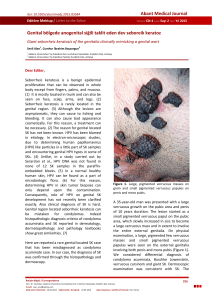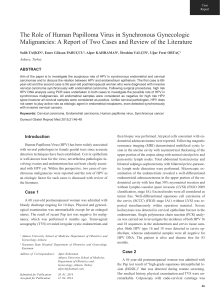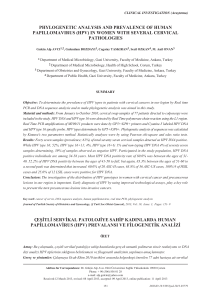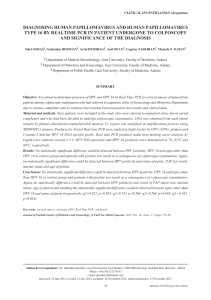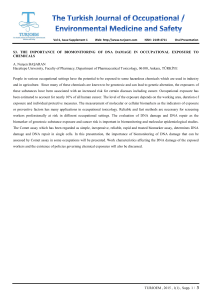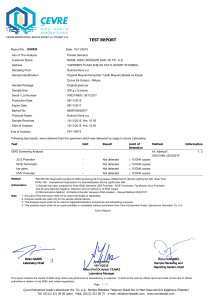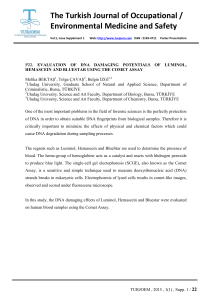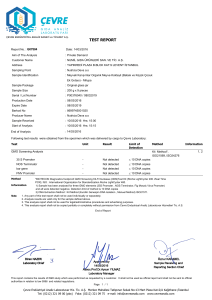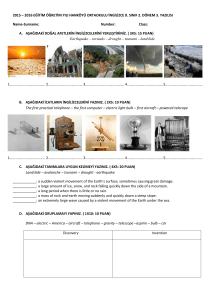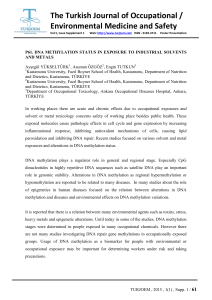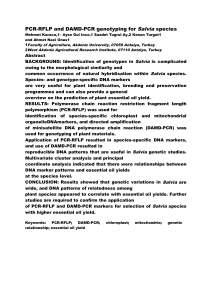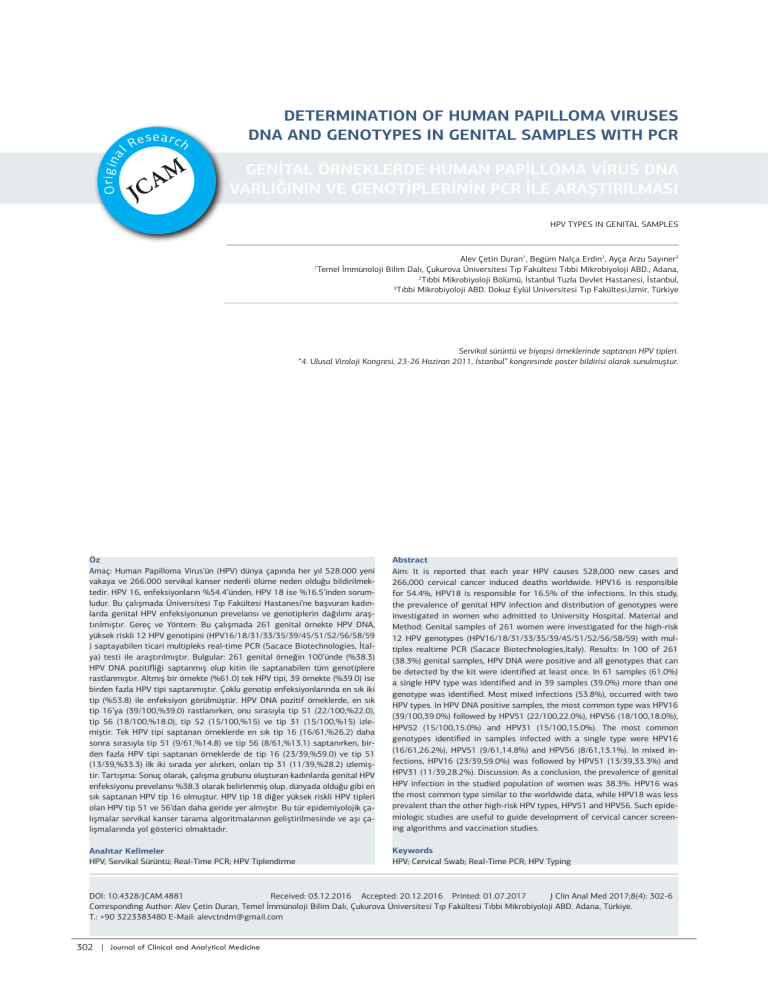
O ri g i na
lR
esearch
DETERMINATION OF HUMAN PAPILLOMA VIRUSES
DNA AND GENOTYPES IN GENITAL SAMPLES WITH PCR
GENİTAL ÖRNEKLERDE HUMAN PAPİLLOMA VİRUS DNA
VARLIĞININ VE GENOTİPLERİNİN PCR İLE ARAŞTIRILMASI
HPV TYPES IN GENITAL SAMPLES
Alev Çetin Duran1, Begüm Nalça Erdin2, Ayça Arzu Sayıner3
Temel İmmünoloji Bilim Dalı, Çukurova Üniversitesi Tıp Fakültesi Tıbbi Mikrobiyoloji ABD., Adana,
2
Tıbbi Mikrobiyoloji Bölümü, İstanbul Tuzla Devlet Hastanesi, İstanbul,
3
Tıbbi Mikrobiyoloji ABD. Dokuz Eylül Üniversitesi Tıp Fakültesi,İzmir, Türkiye
1
Servikal sürüntü ve biyopsi örneklerinde saptanan HPV tipleri.
“4. Ulusal Viroloji Kongresi, 23-26 Haziran 2011, İstanbul” kongresinde poster bildirisi olarak sunulmuştur.
Öz
Amaç: Human Papilloma Virus’ün (HPV) dünya çapında her yıl 528.000 yeni
vakaya ve 266.000 servikal kanser nedenli ölüme neden olduğu bildirilmektedir. HPV 16, enfeksiyonların %54.4’ünden, HPV 18 ise %16.5’inden sorumludur. Bu çalışmada Üniversitesi Tıp Fakültesi Hastanesi’ne başvuran kadınlarda genital HPV enfeksiyonunun prevelansı ve genotiplerin dağılımı araştırılmıştır. Gereç ve Yöntem: Bu çalışmada 261 genital örnekte HPV DNA,
yüksek riskli 12 HPV genotipini (HPV16/18/31/33/35/39/45/51/52/56/58/59
) saptayabilen ticari multipleks real-time PCR (Sacace Biotechnologies, İtalya) testi ile araştırılmıştır. Bulgular: 261 genital örneğin 100’ünde (%38.3)
HPV DNA pozitifliği saptanmış olup kitin ile saptanabilen tüm genotiplere
rastlanmıştır. Altmış bir örnekte (%61.0) tek HPV tipi, 39 örnekte (%39.0) ise
birden fazla HPV tipi saptanmıştır. Çoklu genotip enfeksiyonlarında en sık iki
tip (%53.8) ile enfeksiyon görülmüştür. HPV DNA pozitif örneklerde, en sık
tip 16’ya (39/100,%39.0) rastlanırken, onu sırasıyla tip 51 (22/100,%22.0),
tip 56 (18/100,%18.0), tip 52 (15/100,%15) ve tip 31 (15/100,%15) izlemiştir. Tek HPV tipi saptanan örneklerde en sık tip 16 (16/61,%26.2) daha
sonra sırasıyla tip 51 (9/61,%14.8) ve tip 56 (8/61,%13.1) saptanırken, birden fazla HPV tipi saptanan örneklerde de tip 16 (23/39,%59.0) ve tip 51
(13/39,%33.3) ilk iki sırada yer alırken, onları tip 31 (11/39,%28.2) izlemiştir. Tartışma: Sonuç olarak, çalışma grubunu oluşturan kadınlarda genital HPV
enfeksiyonu prevelansı %38.3 olarak belirlenmiş olup, dünyada olduğu gibi en
sık saptanan HPV tip 16 olmuştur. HPV tip 18 diğer yüksek riskli HPV tipleri
olan HPV tip 51 ve 56’dan daha geride yer almıştır. Bu tür epidemiyolojik çalışmalar servikal kanser tarama algoritmalarının geliştirilmesinde ve aşı çalışmalarında yol gösterici olmaktadır.
Abstract
Aim: It is reported that each year HPV causes 528,000 new cases and
266,000 cervical cancer induced deaths worldwide. HPV16 is responsible
for 54.4%, HPV18 is responsible for 16.5% of the infections. In this study,
the prevalence of genital HPV infection and distribution of genotypes were
investigated in women who admitted to University Hospital. Material and
Method: Genital samples of 261 women were investigated for the high-risk
12 HPV genotypes (HPV16/18/31/33/35/39/45/51/52/56/58/59) with multiplex realtime PCR (Sacace Biotechnologies,Italy). Results: In 100 of 261
(38.3%) genital samples, HPV DNA were positive and all genotypes that can
be detected by the kit were identified at least once. In 61 samples (61.0%)
a single HPV type was identified and in 39 samples (39.0%) more than one
genotype was identified. Most mixed infections (53.8%), occurred with two
HPV types. In HPV DNA positive samples, the most common type was HPV16
(39/100,39.0%) followed by HPV51 (22/100,22.0%), HPV56 (18/100,18.0%),
HPV52 (15/100,15.0%) and HPV31 (15/100,15.0%). The most common
genotypes identified in samples infected with a single type were HPV16
(16/61,26.2%), HPV51 (9/61,14.8%) and HPV56 (8/61,13.1%). In mixed infections, HPV16 (23/39,59.0%) was followed by HPV51 (13/39,33.3%) and
HPV31 (11/39,28.2%). Discussion: As a conclusion, the prevalence of genital
HPV infection in the studied population of women was 38.3%. HPV16 was
the most common type similar to the worldwide data, while HPV18 was less
prevalent than the other high-risk HPV types, HPV51 and HPV56. Such epidemiologic studies are useful to guide development of cervical cancer screening algorithms and vaccination studies.
Anahtar Kelimeler
HPV; Servikal Sürüntü; Real-Time PCR; HPV Tiplendirme
Keywords
HPV; Cervical Swab; Real-Time PCR; HPV Typing
DOI: 10.4328/JCAM.4881
Received: 03.12.2016 Accepted: 20.12.2016 Printed: 01.07.2017
J Clin Anal Med 2017;8(4): 302-6
Corresponding Author: Alev Çetin Duran, Temel İmmünoloji Bilim Dalı, Çukurova Üniversitesi Tıp Fakültesi Tıbbi Mikrobiyoloji ABD. Adana, Türkiye.
T.: +90 3223383480 E-Mail: [email protected]
302 | Journal of Clinical and Analytical Medicine
Journal of Clinical and Analytical Medicine | 1
HPV TYPES IN GENITAL SAMPLES
HPV TYPES IN GENITAL SAMPLES
admitted to Dokuz Eylül University Hospital Obstetrics and GyIntroduction
necology Clinic were investigated and results were compared
Human papillomaviruses (HPV), which have been proven to
with other study results.
cause cervical cancer, are enveloped, double-stranded, icosahedral, symmetrical DNA viruses classified in Papillomaviridae.
Material and Method
HPV induced cervical cancer is the fourth most prevalent cancer
In this study, the prevalence of genital HPV infection and distritype in women worldwide and accounts for 12% of all cancers
bution of HPV types in women who were admitted to Obstetrics
in women. It is reported that HPV causes 528,000 new cases
and Gynecology Clinic of Dokuz Eylül University Hospital were
worldwide and 266,000 cervical cancer deaths each year [1].
investigated. The study group consisted of 261 female patients,
In less developed countries such as in Africa, cervical cancer
all within the age range of 19-65 (mean age 35.1 ± 9.7), who
is the most common type of cancer in women while the prevawere admitted to the Obstetrics and Gynecology Clinic between
lence of HPV decreases in more developed communities, such
2009 and 2011.
as European countries [2,3]. Sub-Saharan Africa is the most
261 cervical smears and biopsies, were investigated for the 12
prevalent region for cervical cancer with at prevalence of up
high-risk HPV genotypes (HPV 16, 18, 31, 33, 35, 39, 45, 51,
to 33.6%. The prevalence of HPV-associated cervical cancer in
52, 56, 58, 59) with multiplex real-time PCR test (Sacace BioAsian countries has been reported as 9.4% [3]. In the GLOBOtechnologies, Italy) a real-time amplification test for qualitative
CAN study published by the International Cancer Agency (IARC),
detection and typing of stated HPVgenotypes. The test is based
the incidence of cervical cancer in Turkey is 4.31 per 100,000
on two major processes: isolation of DNA from specimes and
[1]. According to data from the Turkish Public Health Agency
multiplex real-time amplification of four tubes for each sample.
Cancer Center, cervical cancer in Turkey is the tenth most comEach tube contains primers directed against regions of three
mon cancer among female cancers and constitutes 4.6% of all
HPV types and the ß-globine gene used as internal control.
cancers in women.
It is difficult to determine the true prevalence and distribution
Results
of HPV types in our country since studies are performed in difHPV DNA was positive (mean age:33.7±9.1) in 100 of 261
ferent small study groups and using different techniques. There
(38.3%) cervical samples. In 61 samples (61.0%) a single HPV
are three main methods for the diagnosis of HPV: thus some
type was identified, in 39 samples (39.0%) more than one HPV
differences in results could be due to the method used in the
type (mixed infections) was identified. Most mixed infections,
studies. The methods are direct hybridisation methods (south(21/39, 53.8%) occurred with two HPV types. In 100 samples, a
ernblot, dotblot, in situ hibridisation), signal amplification test
total of 172 HPV types were identified; 61 of these were from
(Hibridcapture II) and the nucleic acid amplification test (PCR).
the samples containing one HPV type, and 111 were obtained
The sensitivity, specificity and NPV of PCR-based HPV DNA defrom samples containing multiple HPV types (Table 1).
tection methods are higher than for the other techniques [4].
Type distribution in HPV types with single and multiple HPVThere are more than 40 HPV genotypes that cause genital inDNA with mean age are shown in Table 2.
fections [5]. In terms of causing cancer potentials, HPV types
In HPV DNA positive samples, the most common type identified
are classified as low-risk types (HPV 6, 11, 40, 42, 43, 44, 53,
was HPV 16 (39/100, 39.0%) followed by HPV type 51 (22/100,
54, 61, 72, 81) and high-risk types (HPV 16, 18, 31, 33, 35, 39,
22.0%) and HPV type 56 (18/100, 18.0%). When samples with
45, 51, 52, 56, 58, 59, 68, 73, 82) [6,7]. Worldwide, HPV 16 is
singleplex or multiplex infection were examined separately, it
responsible for 54.4% of infections and HPV 18 is responsible
was found that in the samples infected with one type, the most
for 16.5%. In 70% of all invasive cervical cancers the causative
agent is HPV 16 and 18 [8,9].
Table 1. Results of HPV DNA and type distribution in 261 cervical samples
Currently, there are three approved
HPV Types
HPV DNA positive
Infection with
Infection with
HPV DNA negative
HPV vaccines available for the presamples n(%)
single HPV type
multiple HPV types samples n(%)
vention of cervical cancer caused by
n(%)
n(%)
HPV. Existing vaccines are not proType16
39 (39/100, 39.0%)
16 (16/61, 26.2%)
23 (23/39, 59.0%)
tective against all HPV types. These
Type 51
22 (22/100, 22.0%)
9 (9/61, 14.8%)
13 (13/39, 33.3%)
vaccines are two-valent HPV 16/18
Type 56
18 (18/100, 18.0%)
8 (8/61, 13.1%)
10 (10/39, 25.6%)
(Cervarix® GlaxoSmithKline, UK),
Type 52
15 (15/100, 15.0%)
5 (5/61, 8.2%)
10 (10/39, 25.6%)
quadrivalent HPV 16/18/6/11 (GardaType 31
15 (15/100, 15.0%)
4 (4/61, 6.6%)
11 (11/39, 28.2%)
sil® Merck & Co, USA) vaccines, and
Type 39
13 (13/100, 13.0%)
7 (7/61, 11.4%)
6 (6/39, 15.4%)
a second generation vaccine Gardasil
Type 18
13 (13/100, 13.0%)
5 (5/61, 8.2%)
8 (8/39, 20.5%)
9® (HPV 6,11,16,18,31,33,45,52,58)
Type 59
11 (11/100, 11.0%)
1 (1/61, 1.6%)
10 (10/39, 25.6%)
containing nine HPV types [10,11].
Type 35
9 (9/100, 9.0%)
2 (2/61, 3.3%)
7 (7/39, 17.9%)
Determination of the distribution of
Type 45
7 (7/100, 7.0%)
2 (2/61, 3.3%)
5 (5/39, 12.8%)
HPV types in a specific community is
Type 33
5 (5/100, 5.0%)
1 (1/61, 1.6%)
4 (4/39, 10.3%)
an important consideration in deterType 58
5 (5/100, 5.0%)
1 (1/61, 1.6%)
4 (4/39, 10.3%)
mining vaccination policies.
Total number of
100 (100/261, 38.3%) 61 (61/261, 23.4%) 39 (39/261, 14.9%) 161 (161/261, 61.7%)
In this study, the distribution of HPV
samples (n:261)
types and the prevalence of genital
Total number of
172 (172/172,
61(61/172, 35.5%)
111 (111/261,
genotypes (n:172) 100.0%)
64.5%)
HPV infection in women who were
2 | Journal of Clinical and Analytical Medicine
Journal of Clinical and Analytical Medicine | 303
HPV TYPES IN GENITAL SAMPLES
Figure 1. Distribution of HPV types in HPV DNA positive samples
common types were HPV 16 (16/61, 26.2%), HPV 51 (9/61,
14.8%) and HPV 56 (8/61, 13.1%). In mixed infections HPV 16
(23/39, 59.0%) was most common, followed by HPV 51 (13/39,
33.3%) and HPV 31 (11/39, 28.2%) ( Table 1 and Figure 1).
Discussion
After persistent infection with high-risk HPV types, it takes a
long time to develop cervical cancer. Prevention or early detection of cervical cancer is possible by the application of various
screening programs (Pap smear and / or HPV DNA detection)
and preventive health services (HPV vaccination). In many European countries, such as the United Kingdom, Finland, Italy and
the Netherlands, it is reported that screening, follow-up and
protection programs reduce the incidence and mortality of HPV
[12].
The role of HPV types in the transformation of cervical cancer is
well known. For this reason, besides the presence of HPV DNA,
genotyping has a critical role. It is important to identify the distribution of HPV types and infections caused by multiple types
to improve disease management and vaccination programs.
The prevalence of HPV, the distribution of HPV types, and the
frequency of multiple infections vary according to the region
and the characteristics of the study groups [13].
Since studies on HPV infections in Turkey are conducted in limited populations and centers, it is difficult to determine the actual prevalence and distribution of HPV types. The National HPV
screening project, targeting women aged 30-65, has recently
been initiated by the Ministry of Health, Public Health Agency,
Cancer Department. According to the first published results,
839,756 women were screened and HPV DNA positivity was
detected in 29,240 (3.48%) of them.
In this study, we aimed to contribute to our country’s data by
investigating the prevalence of genital HPV infection and the
distribution of HPV types in our study group.
HPV DNA was detected in 38.3% (100/261) of the samples examined in our study. 61 (61.0%) of HPV DNA positive specimens
had a single HPV type and 39 (39.0%) had more than one HPV
type (Table 1 and 2). When compared with studies of similar
patient groups and methods, HPV positivity was higher in our
study.
HPV DNA positivity has been reported to range from 3.2% to
30.6% in studies investigating the presence of HPV by the PCR
method in patients admitted to different outpatient clinics in
Turkey (Table 3) [14-19]; this rate increases to a range of 57.5%
to 70.0% in patients with cytologic atypia [20-22].
In our study, the most frequent type was HPV 16 (39.0%) followed by type 51 (22.0%), type 56 ( 18.0%), type 52 (15.0%)
and type 31 (15.0%) (Table 1). HPV type 16 was also found to
be the most common type in different epidemiological studies
in Turkey, similar to our findings. However, the types following
HPV 16 differ between studies (Table 3) [14-20]. In the study
conducted by Unal et al. [18] HPV type 16, type 56 and type 51
were the most common three types respectively, similar to the
Table 2. Co-infection patterns and genotype distribution
Infection with single HPV
type (n:61) (mean age)
Two HPV types
(n:21) (mean age)
Three HPV types (n:10)
(mean age)
Four HPV types
(n:3) (mean age)
Five HPV types
(n:4) (mean age)
Seven HPV types
Type 16 (n:16) 37.2±13.3)
Type 16,18 (n:2) (31.0±5.7)
Type 39,45, 51 (n:1)(25.0)
Type 31,39,51,52
(n:1)(37.0)
Type 16,31,45, 52,59
(n:1) (31.0)
Type16,18,31,35,45,51,58
(n:1) (24.0)
Type 51 (n:9) (33.1±8.8)
Type 16,33 (n:2) (40.0±14.1)
Type 16,31, 51 (n:1)(27.0)
Type 31,33,52,59
(n:1)(22.0)
Type 18,45,51, 52,59
(n:1) (38.0)
Type 56 (n:8) (33.1±6.3)
Type 16,35 (n:2) (37.5±5.0)
Type 51,56, 58 (n:1)(24.0)
Type 16,18,31,56
(n:1)(39.0)
Type 16,33,52, 56,59
(n:1) (27.0)
Type 39 (n:7) (38.7±6.8)
Type 16,51 (n:2) (34.5±0.7)
Type 18,56, 59 (n:1)(35.0)
Type 52 (n:5) (27.4±5.7)
Type 16,31 (n:1) (22.0)
Type 16,35, 52 (n:1)(34.0)
Type 18 (n:5) (42.4±12.8)
Type 16,39 (n:1) (27.0)
Type 18,45, 51 (n:1)(24.0)
Type 31 (n:4) (32.3±9.4)
Type 16,56 (n:1) (27.0)
Type 16,51, 52 (n:1)(34.0)
Type 35 (n:2) (24.5±0.7)
Type 16,59 (n:1)(39.0)
Type 16,58, 59 (n:1)(23.0)
Type 45 (n:2) (27.5±9.2)
Type 18,56 (n:1) (35.0)
Type 16,35, 58 (n:1)(39.0)
Type 59 (n:1) (41.0)
Type 39,56 (n:1) (35.0)
Type 16,39, 59 (n:1) (37.0)
Type 33 (n:1) (31.0)
Type 51,59 (n:1) (33.0)
Type 58 (n:1) (28.0)
Type 52,59 (n:1) (39.0)
Type 31,51 (n:1) (24.0)
Type 35,52 (n:1) (29.0)
Type 31,56 (n:1) (47.0)
Type 35,56 (n:1) (28.0)
| Journal
of Clinical
and Analytical
Medicine
3304
| Journal
of Clinical
and Analytical
Medicine
Type 16,31,39, 51,56
(n:1) (35.0)
HPV TYPES IN GENITAL SAMPLES
HPV TYPES IN GENITAL SAMPLES
the effectiveness of the current vaccines over
the years and to develop vaccine applications
The most
according to the needs of the HPV genotype
frequent HPV
distribution.
types
The prevalence of infection with multiple HPV
genotypes also varies according to the regions.
Tip 16 (36.0%)
The frequency of mixed infection was reportTip 6 (22.0%)
ed in the range of 0.5-28.7% in an outpatient
Tip 18 (13.0%)
population screened by PCR-based assays
Tip 11 (4.4%)
in Turkey (Table 3). In patients with cytologic
Tip 45 (4.4%)
atypia this rate is higher, at 45.5%. Worldwide
Tip 16 (33.3%)
studies report mixed infections as nearly 40%
Tip 45 (20.8%)
of all HPV infections [23]. In a study conducted
Tip 18 (4.2%)
by Clifford et al. [24], the frequency of mixed
Tip 31 (4.2%)
infections was reported as 11.5-42.4% using
Tip 16 (33.7%)
the same method as used in different regions.
Tip 52 (12.6%)
In our study, the frequency of mixed infections
Tip 58 (11.6%)
was determined to be 39.0% with at most two
Tip 18 (7.4%)
different HPV types (53.8%). Multiple infections
Tip 31 (7.4%)
with three, four, five and seven HPV types were
Tip 35 (7.4%)
detected at decreasing rates (Table 2). The preTip 16 (46.3%)
valance of mixed infection in our study is higher
Tip 31 (17.0%)
than the similar studies (0,5%-28,7%) reported
Tip 51 (17.0%)
from Turkey (Table 3).
Tip 42 (8.3%)
It is stressed that multiple HPV infections may
Tip 33 (7.9%)
be higher in HIV-infected individuals and those
Tip 16 (22.0%)
with advanced cytologic atypia [25]. It is also
Tip 56 (13.5%)
emphasized that mixed HPV infection may be
Tip 51 (11.8%)
associated with persistence although. However,
Tip 31 (8.5%)
the interaction of different HPV types detected
Tip 59 (8.5%)
in mixed infections and the effect of this interTip 16 (32.0%)
action on cervical cancer transformation has
Tip 6 (17.0%)
not yet been fully elucidated [13].
Tip 11 (9.0%)
As a summary, HPV DNA was positive in 38.3%
Tip 18 (8.0%)
of our study population with 39% being mixed
Tip 31 (6.6%)
infection. The most common type was HPV 16
which is similar to data gathered from other
Turkish studies. There are differences between the frequency
and order of the HPV genotypes detected at the second and
subsequent frequencies. It is difficult to determine the true
prevalence and distribution of HPV types in Turkey since studies
are generally conducted in small groups and at certain centers.
The results of the community-based “Cervical Cancer Screening
Program” conducted by the Public Health Agency Cancer Center
will be provide guidance for further investigation.
Table 3. Prevalence of HPV DNA and genotype distribution identified by PCR based assays in outpatient studies from Turkey
Study
Region/year
Study
group
(n)
Age
(mean
age)
HPV-DNA
Positivity
Infection with
multiple HPV
types
Polat et al [14]
Ankara/2009
403
19-67
(37.5)
93
(23.0%)
(11.1%)
Altun et al [15]
Adana/2011
460
20-68
24 (5.2%)
5 (5/24,
20.8%)
Şahiner et al [16]
Ankara/2012
356
16-64
(38.0)
109
(30.6%)
29 (29/101,
28.7%)
Yüce et al [17]
Ankara/2012
890
20-70
(39.5)
229
(25.7%)
54 (54/229,
23.6%)
Ünal et al [18]
Antalya/2013
1137
20-66
36 (3.2%)
Polat et al [19]
Multicenter
study/2013
6388
15-76
(38.9)
1588
(25.0%)
8 (8/1588,
0.5%)
results in our study. As in some other studies, HPV type 18 was
less common than the other high-risk HPV types in our findings
[17,18,20].
In a meta-analysis consisting of 1,016,719 women and 194 trials using PCR or Hybrid Capture 2 methods, HPV prevalence
was reported as 11.7% globally and 1.7% in Turkey. The most
common genotypes worldwide were HPV 16 (3.2%), HPV 18
(1.4%), HPV 52 (0.9%), HPV 31 (0.8%), HPV 58 (0.7%) and HPV
39 (0.6%), HPV 56 (0.6%), HPV 53 (0.6%), and HPV 51 (0.6%)
at equal prevalence. However, it has been emphasized that
the distribution of genotypes varies between regions. In the
Asian region in which Turkey is located, HPV 16 (2.5%), HPV
18 (1.4%), HPV 52 (0.7%) infections were reported and HPV
51 (0.5%), HPV 58 (0.5%), HPV 53 (0.5%), HPV 56 (0.5%) were
at equal prevalance; HPV 39 infections were reported at 0.4%
[3]. Although the distribution of HPV genotypes varies between
regions, HPV 16 infection is most common in all regions [3,9].
Existing vaccines are not protective against all HPV types. The
last FDA approved vaccine is nine-valent Gardasil 9® which currently has the widest coverage, containing nine HPV types (HPV
6, 11, 16, 18, 31, 33, 45, 52, 58). It will be appropriate to revise
4 | Journal of Clinical and Analytical Medicine
Competing interests
The authors declare that they have no competing interests.
References
1. Ferlay J, Soerjomataram I, Dikshit R, Eser S, Mathers C, Rebelo M et al. Cancer
incidence and mortality worldwide: sources, methods and major patterns in GLOBOCAN 2012. Int J Cancer 2015;136(5):E359-86.
2. Bray F, Jemal A, Grey N, Ferlay J, Forman D. Global cancer transitions according
to the Human Development Index (2008–2030): a population based study. Lancet
Oncol 2012;13(8):790–801.
3. Bruni L, Diaz M, Castellsague´ X, Ferrer E, Bosch FX, de Sanjose´ S. Cervical human papillomavirus prevalence in 5 continents: Meta-analysis of 1 million
women with normal cytological findings. J Infect Dis 2010;202(12):1789–99.
4. Van Hamont D, Bekkers RL, Massuger LF, Melchers WJ. Detection, management,
and follow-up of pre-malignant cervical lesions and the role for human papillomavirus. Rev Med Virol 2008;18(2):117-32.
Journal of Clinical and Analytical Medicine | 305
HPV TYPES IN GENITAL SAMPLES
5. De Villiers EM. Cross-roads in the classification of papillomaviruses. Virology
2013;445(1-2):2–10.
6. Muñoz N, Bosch FX, de Sanjosé S, Herrero R, Castellsagué X, Shah KV et al.
Epidemiologic classification of human papillomavirus types associated with cervical cancer. N Engl J Med 2003;348(6):518–27.
7. Doorbar J, Quint W, Banks L, Bravo IG, Stoler M, Broker TR et al. The biology and
life-cycle of human papillomaviruses. Vaccine 2012;30 Suppl 5:F55–70.
8.Smith JS, Lindsay L, Hoots B, Keys J, Franceschi S, Winer R et al. Human papillomavirus type distribution in invasive cervical cancer and high-grade cervical
lesions: a meta-analysis update. Int J Cancer 2007;121(3):621–32.
9. Asiaf A, Ahmad ST, Mohammad SO, Zargar MA. Review of the current knowledge on the epidemiology, pathogenesis, and prevention of humanpapillomavirüs
infection. Eur J Cancer Prev 2014;23(3):206-24.
10. Arbyn M, Dillner J. Review of current knowledge on HPV vaccination: an appendix to the European Guidelines for Quality Assurance in Cervical Cancer Screening.
J ClinVirol 2007;38(3):189-97.
11. Zhai L, Tumban E. Gardasil-9: A global survey of projected efficacy. Antiviral
Res 2016; 130:101-9.
12. Elfström KM, Arnheim Dahlström L, von Karsa L, Dillner J. Cervical cancer
screening in Europe: Quality assurance and organisation of programmes. Eur J
Cancer 2015;51(8):950–68.
13. Baseman JG, Koutsky LA. The epidemiology of human papillomavirus infections. J ClinVirol 2005;32(Suppl 1):16-24.
14. Dursun P, Senger SS, Aslan H, Kuşçu E, Ayhan A. Human papillomavirus (HPV)
prevalence and types among Turkish women at a gynecology outpatient unit. BMC
Infect Dis 2009;9:191-6.
15. Altun Z, Yarkın F, Vardar MA, Uguz AH. The Prevelance of HPV Infection Among
Women who Admitted to Cukurova University Faculty of Medicine Hospital. J Med
Sci 2011;31(2):307-14.
16. Sahiner F, Gumral R, Sener K, Yiğit N, Dede M, Yapar M et al. Investigation of
HPV DNA in Cervical Smear Samples by Two Different Methods: MY09/11 Consensus PCR and Type Specific Real Time PCR. Mikrobiyol Bul 2012;46(4):624-36.
17. Yuce K, Pınar A, Salman MC, Alp A, Sayal B, Dogan S et al. Detection and
genotyping of cervical HPV with simultaneous cervical cytology in Turkish women:
a hospital based study. Arch Gynecol Obstet 2012;286(1):203–8.
18. Unal B, Sezer C. Analysis of High Risk HPV Subtypes Associated with Cervical
Intraepithelial Neoplasia: A Single Centre Retrospective Study in the Mediterranean Region of Turkey. Turkish Journal of Pathology 2014;30(1):85-6.
19. Dursun P, Ayhan A, Mutlu L, Çağlar M, Haberal A, Güngör T et al. HPV Types
in Turkey: Multicenter Hospital Based Evaluation of 6388 Patients in Turkish Gynecologic Oncology Group Centers. Turkish Journal of Pathology 2013;29:210-6.
20. Ergunay K, Mısırlıoğlu M, Fırat P, Tuncer ZS, Tuncer S, Yildiz I et al. Detection
and Typing of Human Papilloma Virus by Polymerase Chain Reaction and Hybridization assay in Cervical Samples with Cytological Abnormalities. Mikrobiyol Bul
2008;42(2):273-82.
21. Yavuzer D, Karadayı N, Erdağı A, Salepci T, Baloğlu H, Dabak R. Serviks kanseri
ve prekanseröz lezyonlarında PCR ile HPV tiplemesi. J Kartal TR 2009;20(1):1-6.
22. Avcı GA, Bozdayı G, Taskıran C, Ozkan S, Onan MA. Phylogenetic Analysis and
Prevalence of Human Papillomavirus (HPV) in women with Several Cervical Pathologies. J Turk Soc Obstet Gynecol 2013;10:151- 9.
23. Lorenzi AT, Syrjänen KJ, Longatto-Filho A. Human papillomavirus (HPV)
screening and cervical cancer burden. A Brazilian perspective. Virology Journal
2015;12:112.
24. Clifford GM, Gallus S, Herrero R, Muñoz N, Snijders PJ, Vaccarella S et al.
Worldwide distribution of human papillomavirus types in cytologically normal
women in the International Agency for Research on Cancer HPV prevalence surveys: a pooled analysis. Lancet 2005;366(9490):991-8.
25. Levi JE, Kleter B, Quint WG, Fink MC, Canto CL, Matsubara R et al. High
prevalence of human papillomavirus infections and high frequency of multiple
genotypes in HIV infected women in Brazil. J Clin Microbiol 2002;40(9):3341-5.
How to cite this article:
Duran AÇ, Erdin BN, Sayıner AA. Determination of Human Papilloma Viruses DNA
and Genotypes in Genital Samples with PCR. J Clin Anal Med 2017;8(4): 302-6.
| Journal
of Clinical
and Analytical
Medicine
5306
| Journal
of Clinical
and Analytical
Medicine

